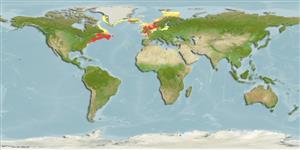Classification / Names
Common names from other countries
Main reference
Size / Weight / Age
Max length : 130 cm TL male/unsexed; (Ref. 1371); common length : 60.0 cm TL male/unsexed; (Ref. 4645); max. published weight: 32.0 kg (Ref. 7251); max. reported age: 25 years (Ref. 1371)
Length at first maturity
Lm 39.1 range ? - ? cm
Environment
Marine; demersal; oceanodromous (Ref. 51243); depth range 37 - 364 m (Ref. 5951)
Climate / Range
Temperate, preferred 6°C (Ref. 107945); 77°N - 33°N, 76°W - 35°E
Distribution
Eastern Atlantic: Barents Sea, Spitsbergen to Bay of Biscay, around Iceland. Western Atlantic: southwest Greenland, Hudson Strait to North Carolina, although rare at the extremes of the range. Migrations for spawning are known to occur. Also long-distance north-south migrations for Europe and the US.
Countries | FAO areas | Ecosystems | Occurrences | Introductions
Short description
Dorsal
spines
(total): 0;
Anal
spines: 0. Chin barbel small. Lateral line smooth along its entire length. Body color is brownish-green dorsally, becoming only slightly paler ventrally. The lateral line pale.
IUCN Red List Status (Ref. 115185)
Threat to humans
Harmless
Human uses
Fisheries: highly commercial; gamefish: yes
Tools
Special reports
Download XML
Internet sources
Estimates of some properties based on models
Phylogenetic diversity index
PD50 = 0.7500 many relatives (e.g. carps) 0.5 - 2.0 few relatives (e.g. lungfishes)
Trophic Level
4.3 ±0.4 se; Based on diet studies.
Resilience
Medium, minimum population doubling time 1.4 - 4.4 years (rm=0.55-0.87; K=0.07-0.17; tm=2-10; tmax=25; Fec=220,000)
Vulnerability
High vulnerability (59 of 100)
Price category
